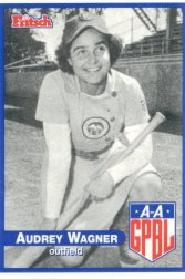Audrey Wagner
| Audrey Wagner | |||
|---|---|---|---|
 |
|||
| All-American Girls Professional Baseball League | |||
| Center field / Right field | |||
|
Born: December 27, 1927 Bensenville, Illinois |
|||
|
Died: August 31, 1984 (aged 56) Rock Springs, Wyoming |
|||
|
|||
| debut | |||
| 1943 | |||
| Last appearance | |||
| 1949 | |||
| Career statistics | |||
| At-bat | 2464 | ||
| Runs | 289 | ||
| Hits | 627 | ||
| Home runs | 29 | ||
| Runs batted in | 281 | ||
| Batting average | .254 | ||
| Games played | 694 | ||
| Teams | |||
| Career highlights and awards | |||
|
|||
Genevieve "Audrey" Wagner [Audrey] (December 27, 1927 – August 31, 1984) was an outfielder who played from 1943 through 1949 in the All-American Girls Professional Baseball League. Listed at 5 ft 7 in (1.70 m), 145 lb., she batted and threw right-handed.
Audrey Wagner was one of the sixty original founding members of the All-American Girls Professional Baseball League. A two-time member of the All-Star Team, she ranks eight in the all-time list with 29 career home runs while her 55 triples rank second all-time to Eleanor Callow (60). Wagner earned Player of the Year honors in 1948, and also led several offensive categories over her seven-year career in the league. She later became an All Star outfielder in each of her four seasons in the competing National Girls Baseball League of Chicago. Following her baseball career, she graduated as Doctor of Medicine.
Wagner was born and grew up in Bensenville, Illinois, and began to play sandlot ball with the boys of her neighborhood when she was a little girl. At age 15, she attended Bensenville Community High School, where she heard about Philip K. Wrigley and his remarkable experiment in creating a women professional baseball league during World War II. Wrigley, who was in charge both of the Wrigley Company and the Chicago Cubs Major League Baseball club, decided to found the All-American Girls Professional Baseball League as a promotional sideline to maintain interest in baseball. By then, the military draft was depleting Major League rosters of first-line players and attendance declined at ballparks around the country. The league started its first season in 1943 with the teams Kenosha Comets, Racine Belles, Rockford Peaches and South Bend Blue Sox, and each team was made up of fifteen girls. Wagner was allocated to the Kenosha Comets, where she played her entire career in the circuit.
...
Wikipedia
